Prag Denkmäler
Prager Burg (Pražský hrad)
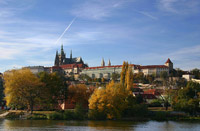
Die Prager Burg (tschechisch: Pražský hrad) bildet das größte geschlossene Burgareal der Welt und liegt auf dem Prager Berg Hradschin. Sie wurde im 9. Jahrhundert gegründet und hat seither ihr Aussehen stark verändert: Generationen von Baumeistern verschiedener Baustile waren daran beteiligt, die einzelnen Etappen der Geschichte hinterließen ihre Spuren. Die Funktion der Burg – Sitz des Staatsoberhauptes – blieb aber stets die gleiche. Heute ist sie offizielle Residenz des Präsidenten der Tschechischen Republik. Inmitten der Burganlage befindet sich der Veitsdom.
Geschichte und …
Lesen Sie mehr
Karlsbrücke (Karlův most)
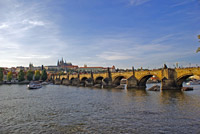
Die Karlsbrücke (tschechisch Karlův most) ist eine im 14. Jahrhundert errichtete, historisch bedeutsame Brücke über die Moldau in Prag, die die Altstadt mit der Kleinseite verbindet. Sie ist eine der ältesten erhaltenen Steinbrücken Europas und eines der Wahrzeichen der Stadt.
Geschichte
Die Grundsteinlegung erfolgte 1357 durch Kaiser Karl IV., angeblich am neunten Tag des siebten Monats um 5:31 Uhr, so dass der Termin sich mit einer regelmäßigen Folge von ungeraden Zahlen wiedergeben lässt: 1-3-5-7-9-7-5-3-1. Die Brücke ersetzte ein Bauwerk aus der romanischen Zeit, die Judithbrücke …
Lesen Sie mehr
Nationalmuseum (Národní muzeum)
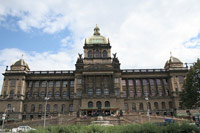
Nationalmuseum ist das führende Museum in Tschechien. Dieser Terminus wird auch für das Hauptgebäude am Wenzelsplatz benutzt.
Geschichte
Das Museum wurde 1818 als Vlastenecké muzeum v Čechách (Nationales Museum in Böhmen) gegründet. Seit 1848 trug es den Namen České muzeum (Böhmisches Museum), in den Jahren 1854 bis 1919 Muzeum Království českého (Museum des Königreichs Böhmen). Vor dem Neubau wurde der Sitz eine Zeit lang in das Sternberger Palais (1821–1846) und das Nostitz-Palais verlegt.
Angefangen hat alles mit Sammlungen böhmischer Aristokraten. Einige der patriotisch gesinnten …
Lesen Sie mehr
Nationaltheater (Národní divadlo)
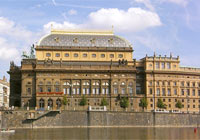
Das Nationaltheater (Národní divadlo) ist eine der bedeutenden Bauten der Neustadt der tschechischen Hauptstadt Prag aus dem 19. Jahrhundert – mit Hilfe von Spenden aus den böhmischen Ländern der in der Folge des Österreichisch-Ungarischen Ausgleichs entstandenen Doppelmonarchie Österreich-Ungarn in den Jahren 1868 bis 1881 im Stil der Neorenaissance errichtet, gilt es auch als nationales Symbol.
Geschichte
Die Idee, in Prag ein unabhängiges tschechisches Theater zu errichten, entstand bereits 1844, worauf František Palacký am 29. Januar 1845 im Regionalparlament einen entsprechenden …
Lesen Sie mehr
Veitsdom (Katedrála svatého Víta)
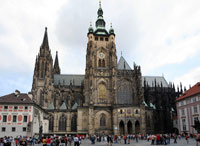
Der Veitsdom (auch St.-Veits-Dom, tschechisch Katedrála oder chrám sv. Víta, voller Name Katedrála svatého Víta, Václava a Vojtěcha) auf der Prager Burg ist das größte Kirchengebäude Tschechiens.
Geschichte
Das Gebäude in seiner heutigen Form als Kathedrale im gotischen Stil wurde ab dem Jahr 1344 auf Anweisung Karls IV. erbaut, als auch Prag zum Erzbistum erhoben wurde, doch reicht die Geschichte des Baus bis in das 10. Jahrhundert zurück. Der Bau erfolgte anstelle einer 925 unter dem Hl. Wenzel errichteten Rotunde und der unter Spytihněv II. begonnenen dreischiffigen romanischen …
Lesen Sie mehr
Altstädter Ring (Staroměstské náměstí)
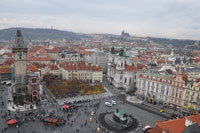
Der Altstädter Ring (Staroměstské náměstí) ist der zentrale Marktplatz der Prager Altstadt. Er nimmt mehr als 9000 m2 ein.
Geschichte
Das historische Rathaus, die Teynkirche, die Hussitenkirche St. Niklas in der Altstadt, das Palais Kinský, das Haus „Zur Steinernen Glocke“ und andere sehenswerte Gebäude umgeben den Platz. Inmitten des Altstädter Rings steht das Denkmal für Jan Hus. In den Kellern der Häuser, welche diesen Platz umgeben, sind romanische und gotische Grundmauern zu finden. Darauf stehen Renaissance-, Barock- und Rokokohäuser.
Am 21. Juni 1621 wurden am Altstädter Ring …
Lesen Sie mehr
Altstädter Rathaus (Staroměstská radnice)
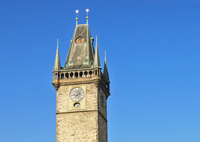
Prague's Old Town Hall was built in 1364. The astronomical clock in the town hall's tower is one of the city's most popular tourist attractions. Originally the building served only as the city hall of the old town, but later became the city hall for all of Prague. It is now only used for ceremonial functions.
The Town Hall
After King John of Luxembourg accorded the citizens of Prague the privilege of having their own district council in 1338, they decided to build a Town Hall, paid for by a duty levied on wine. The almost 70 meters high tower was completed in 1364. Due to continuous …
Lesen Sie mehr
Altstädter Astronomische Uhr (Staroměstský orloj)
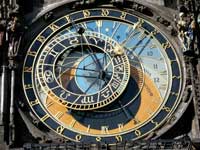
Die Prager Rathausuhr, auch Aposteluhr, oder Altstädter Astronomische Uhr, tschechisch Pražský orloj oder Staroměstský orloj (aus lateinisch horologium), ist eine weltweit bekannte astronomische Uhr aus dem Jahr 1410, die sich in Prag an der Südmauer des Altstädter Rathauses befindet. Sie ist ein Meisterwerk gotischer Wissenschaft und Technik und ein wertvolles Kulturdenkmal.
Geschichte
Die Prager astronomische Uhr ist heute eine der Hauptsehenswürdigkeiten der tschechischen Hauptstadt. Sie wurde nicht in einem Stück gebaut, sondern wuchs im Laufe der Jahrhunderte. Zusammen mit dem …
Lesen Sie mehr
Staatsoper (Státní opera)
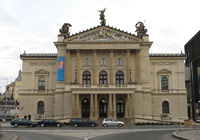
Staatsoper Prag (Státní opera Praha) ist ein Opernhaus in Prag (Tschechien).
Im 19. Jahrhundert wurden in Prager Theatern jeweils zwei Vorstellungen aufgeführt, einmal in deutscher und zum zweiten in tschechischer Sprache. Der Wunsch nach einem eigenen Theater führte 1883 zur Gründung des Deutschen Theatervereins und seinen Bemühungen, eine eigene Bühne zu erbauen. Zu diesem Zweck begann man auch mit der Sammlung von finanziellen Mitteln. 1886 wurde der Plan gebilligt, ein Grundstück von Leopoldine Grustner von Grussdorf (Landgut Smetanka) erworben, an dessen Grund bereits das Neustädter …
Lesen Sie mehr
Wenzelsplatz (Václavské náměstí)
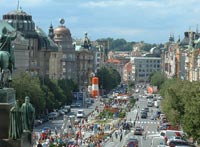
Der Wenzelsplatz (tschech. Václavské náměstí) in der Mitte von Prag wurde 1848 nach dem Heiligen Wenzel von Böhmen benannt, nachdem er im Mittelalter und der Neuzeit als Rossmarkt (Koňský trh) den Mittelpunkt der Prager Neustadt bildete. Die Breite von gut 50 m entspricht zwar nur einer Prachtstraße, aber mit über 700 m Länge gehört der Boulevard zu den größten „Plätzen“ in Europa.
Die Entstehung des Platzes im Mittelalter
Mit der Gründung der Prager Neustadt 1348 unter König Karl IV. wurde entlang eines bestehenden Weges genau rechtwinklig zum Markt der Gallusstadt als eigenständiger …
Lesen Sie mehr
Waldsteinpalais (Valdštejnský palác)
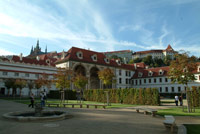
Das Palais Waldstein oder Wallensteinpalais (tschechisch Valdštejnský palác) ist das größte Palais in Prag. Es befindet sich auf der Prager Kleinseite.
Der Palast wurde in den Jahren 1623-1630 im Auftrag von Albrecht Wenzel Eusebius von Waldstein, besser bekannt als Wallenstein, im Stil des frühen böhmischen Barocks erbaut, besitzt allerdings auch noch manieristische Züge. Ausgeführt wurde der Bau durch den Architekten Giovanni Pieroni, einem Schüler Galileo Galileis, unter Mitwirkung des Steinmetzen Zacharias Bussi de Campione. Die Entwürfe stammen von Andrea Spezza.
Die Loggia des …
Lesen Sie mehr
Palais Kinsky (Palác Kinských)
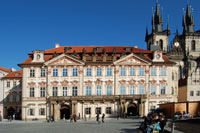
Palais Goltz-Kinsky, tschechisch Palác Goltz-Kinských, ist ein Palais am Altstädter Ring (Staroměstské náměstí), einem Marktplatz der tschechischen Hauptstadt Prag.
Es wurde in den Jahren 1755-1765 an der Stelle zweier mittelalterlicher Häuser im Auftrag von Johann Ernst Graf von der Goltz errichtet. Die ursprünglichen Entwürfe stammen von Kilian Ignaz Dientzenhofer, der jedoch noch vor Baubeginn 1751 verstarb. Sein Werk führte der italienische Baumeister Anselmo Lurago fort. Nach Fertigstellung des Baues verstarb der Bauherr, und seine Witwe verkaufte das Gebäude an die böhmische …
Lesen Sie mehr
Gemeindehaus (Obecní dům)
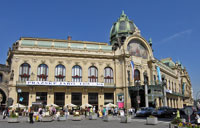
The Municipal House (in Czech, Obecní dům) is a major civic landmark and concert hall in Prague, and an important building in architectural and political history in the Czech Republic. It stands on the Náměstí Republiky.
Around 1900, the building was commissioned by the city on an odd-shaped lot and the subject of one architectural competition, then another, both unsatisfactory. The job was then simply given to architects Osvald Polívka and Antonín Balšánek, who served as much as artistic coordinators as designers. Construction started in 1905 and it opened in 1912.
The Art Nouveau …
Lesen Sie mehr
Pulverturm (Prašná brána)
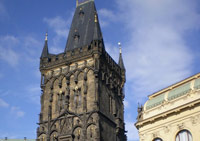
Der Prager Pulverturm (tschechisch: Prašná brána) ist ein 65 Meter hoher gotischer Pulverturm in Prag, der seinen Namen dem bis Ende des 17. Jahrhunderts hier gelagerten Schwarzpulver verdankt.
1475 wurde mit dem Turmbau begonnen. Erst 400 Jahre später wurden die Bauarbeiten beendet. Im Jahre 1484 wurden die Arbeiten an diesem Repräsentationsobjekt abgebrochen, da König Vladislav II. seinen Amtssitz von der Altstadt in die Burg verlegte. Der Turm hatte lange Zeit ein provisorisches Dach. Erst im Jahre 1886 wurde er bei einer Restaurierung unter Leitung von Josef Mocker im neugotischen Stil …
Lesen Sie mehr
Teynkirche (Týnský chrám)
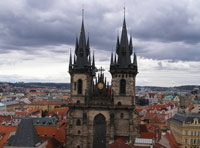
1365 begann man mit dem Bau der dreischiffigen, gotischen Teynkirche (Týnský chrám), auch „Kirche der Jungfrau Maria vor dem Teyn“ (Kostel Panny Marie před Týnem) genannt. Erst in der zweiten Hälfte des 15. Jahrhunderts und zu Beginn des 16. Jahrhunderts wurden die Türme (Adam und Eva) fertiggestellt, die sich nicht gleichen und von denen einer 80 m hoch ist. 1390 wurde in Peter Parlers Hütte das Tympanon über dem Nordportal erschaffen. Es stellt die Leiden Christi dar. Im Inneren befinden sich eine gotische Kanzel, die am Altar des nördlichen Seitenschiffes zu sehende Kalvarienszene aus …
Lesen Sie mehr
Bethlehemskapelle (Betlémská kaple)
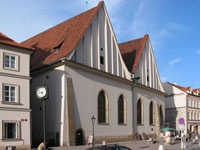
The Bethlehem Chapel (Czech: Betlémská kaple) is a medieval religious building in Prague, Czech Republic notable for its connection with the Czech reformer Jan Hus. It was opened for sermons in 1394, and taught solely in the Czech vernacular, thus breaking with German domination of the Medieval Bohemian church. The building was never officially called as a church, only a chapel.
In the 17th century, the building was acquired by the Jesuits. During reign of the Emperor Joseph II (1780s) converted into an apartment building. Under the Czechoslovakian communist regime the building was …
Lesen Sie mehr
Carolinum (Karolinum)
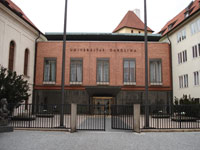
Karolinum (formerly Latin: Collegium Carolinum, in Czech Karlova kolej) is a complex of buildings located in the Old Town of the City of Prague. Karolinum, the seat of the Charles University in Prague, is one of the oldest dormitories situated in the Central Europe. The dormitory was named after the Emperor Charles IV.
History
Shortly after the establishing of Charles University in 1348, the young insititution encountered several organizational problems. One of the major complications was the lack of lecture and accommodation rooms for teachers and students. Emperor Charles IV, apparently …
Lesen Sie mehr
Clementinum (Klementinum)
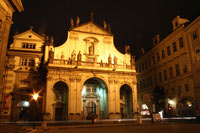
The Clementinum (Klementinum) is a historic complex of buildings in Prague. Today the complex hosts the National, University and Technical libraries, being the City Library also located nearby on Mariánské Náměstí. It is currently in use as the National Library of the Czech Republic. In 2005 the Czech National Library received the UNESCO´s Jikji prize (Memory of the World).
Its history dates from the existence of a chapel dedicated to Saint Clement in the 11th century. A Dominican monastery was founded in the medieval period, which was transformed in 1556 to a Jesuit college. In 1622 the …
Lesen Sie mehr
Rudolfinum
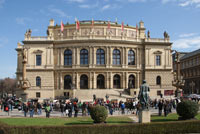
The Rudolfinum is a music auditorium in Prague, Czech Republic. It is one of the most important neo-renaissance buildings in the city and is situated at Jan Palach Square on the bank of the river Vltava.
Since 1946 the Rudolfinum has been the home-stage of the Czech Philharmonic Orchestra and one of the main venues performed in the Dvořák Hall for the Prague Spring International Music Festival held each year in May and June. The building was designed by architect Josef Zítek and his student Josef Schulz, and was opened February 8, 1885. It is named in honour of Rudolf, Crown Prince of …
Lesen Sie mehr
Jindrisska Turm (Jindřišská věž)
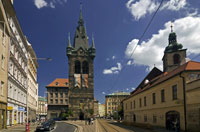
The Jindrisska Tower is a historic bell tower, first built in the 15th century. Renovated in 2001 the tower now features a restaurant and a 10th floor lookout where you have great views over the city.
History
At 65.7 meter (216 ft), the Jindrisska Tower is the tallest free-standing bell tower in Prague. Its history goes back to 1475 when it was built in wood as the bell tower of the Church of St. Henry and Kunhuta (kostel sv Jindrich a Kunhuty), the parish church of New Town.
The current stone version was built at the end of the 16th century. The tower was damaged several times, first …
Lesen Sie mehr
Georgskirche (Bazilika svatého Jiří)
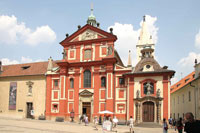
St. George's Basilica (Czech: Bazilika Sv. Jiří) is the oldest surviving church building within Prague Castle, Prague, Czech Republic. The basilica was founded by Vratislaus I of Bohemia in 920. It is dedicated to Saint George.
The basilica was substantially enlarged in 973 with the addition of the Benedictine St. George's Abbey. It was rebuilt following a major fire in 1142. The Baroque façade dates from the late 17th century. A Gothic style chapel dedicated to Ludmila of Bohemia holds the tomb of the saint. The shrines of Vratislav and Boleslaus II of Bohemia are also in the basilica. …
Lesen Sie mehr
St. Nikolaus Kirche (Kostel svatého Mikuláše)
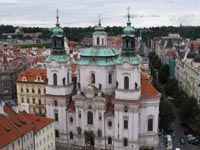
Though smaller and not as rich as the Cathedral of St. Nicholas from the Lesser Town, The Church of St. Nicholas in the Old Town Square plenty deserves its place among Prague’s most appreciated and visited places. If you just think about the eight centuries that it has stood and faced the wickedness of the history you come to look at it in a totally different way.
History
Historical sources mention this place of worship as early as 1273, originally as a parish church, where Hussitism and Reformation used to be preached. Later in the 17th century the church fell into Benedictine …
Lesen Sie mehr
St. Nikolaus Kirche (Chrám svatého Mikuláše)
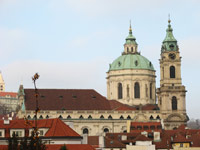
St. Nicholas Church (Cathedral) (Chrám svatého Mikuláše) from the Lesser Quarter in Prague has put its name into Czech and European Baroque era and is now Prague number one church of this kind. Its history is linked to Czech re-catholisation process that followed the defeat of the Hussites in the Battle of the White Mountain (1620).
The beginnings of the imposing Cathedral that we see today go back to the year 1283, when the place of worship started its existence as a parish church under the name and protection of St. Nicholas. With the change of authority in the 17th century, Baroque era …
Lesen Sie mehr
Schwarze Turm (Černá věž)
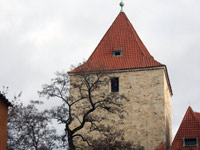
The Black Tower is one of the oldest existing buildings in Prague. It was built in 1135 as an eastern gate of the Romanesque fortification of Prague Castle. You can still see the former gateway on the ground floor, but it is walled up now.
Origin of the name "Black Tower"
The Black Tower belongs to the area of the Supreme Burgrave's House at Prague Castle. Its name "Black" originates from the time of the big fire of Prague Castle in 1541 - its walls remained black for a long time.
However, the tower was called "Golden" in the era of Emperor Charles IV in the 14th century because of its …
Lesen Sie mehr
Vysehrad (Vyšehrad)
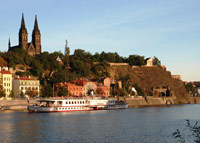
Vysehrad is a castle located in the city of Prague, Czech Republic. It was probably built in the 10th century, on a hill over the Vltava River. Situated within the castle is the Basilica of St Peter and St Paul, as well as the Vysehrad Cemetery, containing the remains of many famous people from the Czech history, among them Antonín Dvořák, Bedřich Smetana and Karel Čapek.
Local legend holds that Vysehrad was the location of the first settlement which would later become Prague, though thus far this claim remains unsubstantiated.
History
When the Přemyslid dynasty settled on the current …
Lesen Sie mehr
Kirche Maria vom Siege (Kostel panny Marie Vítězné)
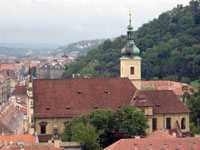
The Church of Our Lady Victorious (Czech: Kostel Panny Marie Vítězné) in Malá Strana, the "small side" of Prague is a Carmelite church and the home of the statue called the "Infant Jesus of Prague".
A chapel dedicated to the Holy Trinity was built on this site in 1584. With the Battle of White Mountain, 8 November 1620, the Counter-Reformation signalled the re-Catholicisation of Prague. The church was given to the direction of the Carmelites in September 1624. The triumphalist altarpiece of Our Lady of Victory was sent from Rome by Pope Gregory XV. The Carmelites were ordered to hand over …
Lesen Sie mehr
Kleinseitner Ring (Malostranské náměstí)
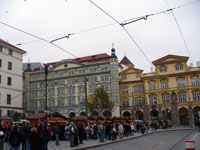
Since it was laid out in 1257, this square has been the heart of Lesser Town (Czech: Malá Strana), a district situated at the foot of the Prague Castle. The square is dominated by St. Nicholas Church, a impressive baroque church that occupies the center of the square.
Magnificent houses with Renaissance and Baroque façades border Lesser Town Square (Czech: Malostranské náměstí) on all sides. During the Middle Ages, when the square was the site of a market for the Prague Castle, the buildings had Gothic designs. A fire that broke out at the square destroyed most of the houses and they were …
Lesen Sie mehr
Petrin (Petřín)
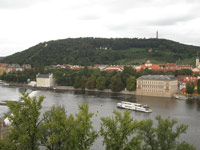
Petřín (327 m) is a hill in the center of Prague, Czech Republic. It rises some 130 m above the left bank of the Vltava River. The hill, almost entirely covered with parks, is a favorite recreational area for the inhabitants of Prague. The hill (in German known as Laurenziberg) is featured prominently in Franz Kafka's early short story "Description of a Struggle" and briefly in Milan Kundera's novel The Unbearable Lightness of Being.
The summit of the hill is linked to Prague's Malá Strana district by the Petřín funicular, a funicular railway that first operated in 1891.
Lesen Sie mehr
Operator
- Telefon: +420 261 264 369
- E-mail: info@arcadira.eu
Touristen Informationen
Tourist Information about Prague and Czech republic. History, Culture, Language, Currency, Visa and much more.
Die Liste unserer Hotels in Prag
Prager 3 Sterne Hotels
- Botel Albatros
- Botel Florentina
- Botel Racek
- Hotel Ankora
- Hotel Arbes - Mepro
- Hotel Atos
- Hotel Donatello
- Hotel Globus
- Hotel Gloria
- Hotel ILF
- Hotel Legie
- Hotel Old Prague
- Hotel Olsanka
- Hotel Olympik Tristar
- Hotel Victoria
- King George´s House
Prager 4 Sterne Hotels
- Hotel Adria
- Hotel Amigo
- Hotel Arkada
- Hotel Barceló
- Hotel Barceló Old Town
- Hotel Caesar Palace
- Hotel Corinthia Panorama
- Hotel Golf
- Hotel Holiday Inn Congress Centre
- Hotel Louis Leger
- Hotel Majestic Plaza
- Hotel Olympik
- Hotel Pyramida
- Hotel Roma
- Hotel Step
- Hotel U Krále Karla
- Hotel U Páva
- Hotel Yasmin
Prager 5 Sterne Hotels
Kontakt
- Pragap Tour, s.r.o. (Arcadira)
- Liliová 10
- 110 00, Praha 1
- Česká republika
- Tel: +420 261 264 369
- Fax: +420 244 400 157
- E-mail: info@arcadira.eu
- Facebook: www.facebook.com
- ICO: 25147412
- DIC: CZ25147412
© 2008-2024 Pragap Tour, s r.o. (Arcadira) | Alle Rechte vorbehalten | Geschäftsbedingungen | Created by Jaroslav Salivar